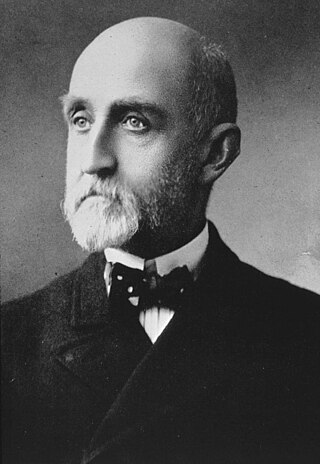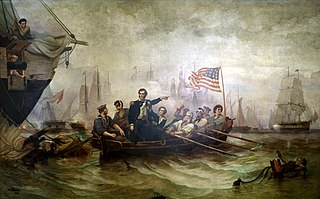
The War of 1812 was fought by the United States and its allies against the United Kingdom and its allies in North America. It began when the United States declared war on Britain on 18 June 1812. Although peace terms were agreed upon in the December 1814 Treaty of Ghent, the war did not officially end until the peace treaty was ratified by the United States Congress on 17 February 1815.

Oliver Hazard Perry was a United States Navy officer from South Kingstown, Rhode Island. A prominent member of the Perry family naval dynasty, he was the son of Sarah Wallace Alexander and Captain Christopher Raymond Perry, and older brother of Commodore Matthew C. Perry.

The Battle of Plattsburgh, also known as the Battle of Lake Champlain, ended the final British invasion of the northern states of the United States during the War of 1812. Two British forces, an army under Lieutenant General Sir George Prévost and a naval squadron under Captain George Downie converged on the lakeside town of Plattsburgh, New York. Plattsburgh was defended by New York and Vermont militia and detachments of regular troops of the United States Army, all under the command of Brigadier General Alexander Macomb, and ships commanded by Master Commandant Thomas Macdonough.

Alfred Thayer Mahan was a United States naval officer and historian, whom John Keegan called "the most important American strategist of the nineteenth century." His 1890 book The Influence of Sea Power Upon History, 1660–1783 won immediate recognition, especially in Europe, and with the publication of its 1892 successor, The Influence of Sea Power Upon the French Revolution and Empire, 1793–1812, he affirmed his status as a globally-known and regarded military strategist, historian, and theorist. Mahan's works encouraged the development of large capital ships — eventually leading to dreadnought battleships — as he was an advocate of the 'decisive battle' and of naval blockades. Critics, however, charged him with failing to adequately explain the rise of largely land-based empires, such as the German or Ottoman Empires, though Mahan did accurately predict both empires' defeats in World War I. Mahan directly influenced the dominant interwar period and World War II-era Japanese naval doctrine of the "decisive battle doctrine", and he became a "household name" in Germany. He also promoted American control over Hawaii though he was "lukewarm" in regards to American imperialism in general. Four U.S. Navy ships have borne his name, as well as various buildings and roads; and his works are still read, discussed, and debated in military, historical, and scholarly circles.

The Battle of Lake Erie, also known as the Battle of Put-in-Bay, was fought on 10 September 1813, on Lake Erie off the shore of Ohio during the War of 1812. Nine vessels of the United States Navy defeated and captured six vessels of the British Royal Navy. This ensured American control of the lake for the rest of the war, which in turn allowed the Americans to recover Detroit and win the Battle of the Thames to break the Indian confederation of Tecumseh. It was one of the largest naval battles of the War of 1812.

The first USS Argus, originally named USS Merrimack, was a brig in the United States Navy commissioned in 1803. She enforced the Embargo Act of 1807 and fought in the First Barbary War – taking part in the blockade of Tripoli and the capture of Derna – and the War of 1812. During the latter conflict, she had been audaciously raiding British merchant shipping in British home waters for a month, when the heavier British Cruizer-class brig-sloopHMS Pelican intercepted her. After a sharp fight during which Argus's captain, Master Commandant William Henry Allen, was mortally wounded, Argus surrendered when the crew of Pelican were about to board.
USS Alligator was a sloop in the United States Navy during the War of 1812. The U.S. Navy purchased Alligator in 1813 at New Orleans, Louisiana. Commissioned as a tender at New Orleans, she served on that station under the command of Captain Robert Hatch until late in 1814 when the British captured her at the Battle of Lake Borgne.

USS Caledonia was a brig, formerly HMS Caledonia, that the United States Navy captured during the War of 1812 and took into American service. The brig played an important role with the American squadron on Lake Erie, and was sold at the end of the war.

The First Battle of Sacket's Harbor was fought on July 19, 1812, between the United States and the British Empire; it was the first engagement of the war between these forces. It resulted in American forces repelling the attack on the village and its important shipbuilding yard, where 12 warships were built for this war.

The capture of HMS Frolic was a naval action fought in the Atlantic on 18 October 1812, between the sloop-of-war USS Wasp, commanded by Master Commandant Jacob Jones, and the Cruizer-class brig-sloopHM Brig Frolic, under Commander Thomas Whinyates. The Americans captured the British vessel, but both vessels shortly thereafter were captured by a British ship of the line which happened upon the scene of the battle.

The capture of USS Chesapeake, also known as the Battle of Boston Harbor, was fought on 1 June 1813, between the Royal Navy frigate HMS Shannon and the United States Navy frigate USS Chesapeake, as part of the War of 1812 between the United States and the United Kingdom. The Chesapeake was captured in a brief but intense action in which 71 men were killed. This was the only frigate action of the war in which there was no preponderance of force on either side.

The capture of HMS Epervier was a naval action fought off the coast of Florida near Cape Canaveral on 28 April 1814, between the United States ship-rigged sloop-of-war USS Peacock, commanded by Master Commandant Lewis Warrington, and the British Cruizer-class brig-sloop Epervier under Commander Richard Wales. The Americans captured the British vessel after a one-sided cannonade, but the British merchant convoy escaped.
Naval strategy is the planning and conduct of war at sea, the naval equivalent of military strategy on land.

Thomas Macdonough, Jr. was a United States Navy officer noted for his roles in the First Barbary War and the War of 1812. He was the son of a revolutionary officer, Thomas Macdonough, Sr. who lived near Middletown, Delaware. He was the sixth child from a family of ten siblings and was raised in the countryside. He entered naval life at an early age, receiving a midshipman's commission at the age of sixteen.

The Influence of Sea Power upon History: 1660–1783 is a history of naval warfare published in 1890 by the American naval officer and historian Alfred Thayer Mahan. It details the role of sea power during the seventeenth and eighteenth centuries, and discussed the various factors needed to support and achieve sea power, with emphasis on having the largest and most powerful fleet. Scholars considered it the single most influential book in naval strategy. Its policies were quickly adopted by most major navies, ultimately leading to the World War I naval arms race. It is also cited as one of the contributing factors of the United States becoming a great power. It was followed by The Influence of Sea Power upon the French Revolution and Empire, 1793–1812, published in 1892.

British and American forces fought several engagements on Lake Ontario for control of the lake during the War of 1812. Ultimately, only a few actions were fought, none of which had decisive results. The contest essentially became a naval building race, sometimes referred to sarcastically as the "Battle of the Carpenters".
William James was a British lawyer and military historian who wrote important histories of the military engagements of the British with the French and Americans from 1793 through the 1820s.

USS Constitution vs HMS Guerriere was a battle between an American and British ship during the War of 1812, about 400 miles (640 km) southeast of Halifax, Nova Scotia. It took place on the 19th of August 1812, one month after the war's first engagement between British and American forces. Guerriere was proceeding to Halifax for a refit, having been detached from a squadron which had earlier failed to capture Constitution. When the two ships encountered each other on August 19th, Guerriere's Captain James Richard Dacres engaged, confident of victory despite facing a bigger, stronger-manned, and better-armed U.S. ship. However, in the exchange of broadsides, Guerriere's masts were felled, and the ship reduced to a sinking condition. Constitution's crew took the British sailors on board and set Guerriere on fire, then returned to Boston with news of the victory, which proved to be important for American morale.

The New Orleans Squadron or the New Orleans Station was a United States Navy squadron raised out of the growing threat the United Kingdom posed to Louisiana during the War of 1812. The first squadron consisted of over a dozen vessels and was mostly defeated during the war. Afterward, new ships were stationed at New Orleans which engaged in counter-piracy operations for over twenty years. The New Orleans Squadron was eventually merged with the Home Squadron.

The Battle of Rappahannock River was fought in 1813 during the War of 1812. A British Royal Navy force blockading the Rappahannock River in Virginia sent several hundred men in boats to attack four American privateers. Ultimately the British were victorious and the American ships were captured.


















